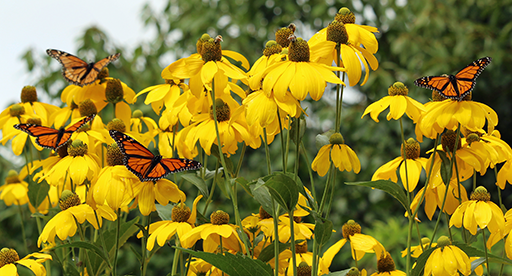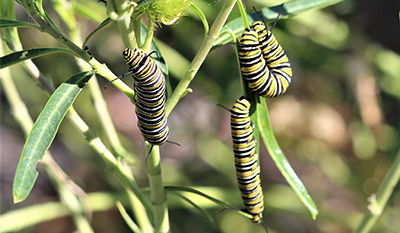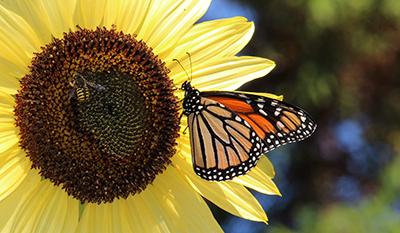
Monarch butterflies are a symbol of summer, gracing our gardens with their big, bright orange and black wings, floating above our colourful flowers. Discover how to encourage more beautiful pollinators like monarchs into your garden.
The Monarch Butterfly Lifecycle
Masses of colour help bring butterflies to your garden. Daisy-shapes also give the butterfly a ‘landing pad’, somewhere on which to rest while they take up nectar with their proboscis.
Stage 1. Monarch butterflies lay their eggs on swan plants (a type of milkweed) and can smell them from up to 1 kilometer away, so planting swan plants will help attract them to your garden. Swan plants which are available in most garden centres.
Stage 2. Once the female lays her eggs, after five about days they hatch. The caterpillars grow to about 2-3cm over a period of two weeks and are eating machines! Children just love them in their ‘striped pyjamas’ of yellow, black and white.

Stage 3. The chrysalis forming is the third stage and after about ten days out unfolds the butterfly. After drying its wings it will flutter away to meet a mate and continue the process.
In some parts of New Zealand you will see monarchs going about their business until well into April or May. When it’s too cold the monarchs find their local overwintering spot. These are usually all trees where their predecessors have left pheromones to show the way. Here they will overwinter in large clusters, not breeding, only looking for nectar when their reserves are low, until in spring when they come back to start the next generation.

Once you’re hooked on monarchs you’ll probably be interested in some of the other amazing butterflies for which New Zealand is famous. See some of them photographed in the beautiful calendar by the Moths and Butterflies of New Zealand Trust, which Tui is proud to sponsor. Check out more information about NZ’s butterflies on their website here.
Article supplied by Moths and Butterflies of New Zealand Trust.
Post a comment
Bring monarch butterflies to your garden Comments
I love seeing these guys around and always have spare hidden plants to feed them.
Bryce Walker
We have a lots of Monarchs here in Papamoa, just love them and all butterflies.
Athena Gray
Very good products.
Malcolm
Monarch butterflies are so impressive and colourful. A joy to see in the garden :)
Storm Alexander
We have lots of Monarch butterflies.
Johan de Bruin
When I retired home to NZ in 2008 I was pleased to see Monarch butterflies in the Horowhenua. There were very few in Western Australia, where I lived for 40 years, and they seemed to be only in Hawkes Bay in NZ. I have grown swan plants and other plants that attract them to my garden and looking out the window now I can see two chasing each other. My nephews love them and that is the first thing they look for when visiting.
Gary Phillips
Transforming magic.
Dorothy Camden
I used to have a lot about four years a go, but they seem to have been affected by the frost. Cheers Fred.
FRED STRANGMAN
Love Monarchs.
Janet Brenton
I enjoy watching the monarch butterflies in the garden.
Raewyn Hogan
Good stuff.
neil clutterbuck
We are redesigning our garden, with the aim of photographing shrubs, birds and wildlife.
Christine Bickel
Recently weeded a overgrown garden a found a swan plant. Lots of butterflies. The plant is always eaten by caterpillars.
Alison Bell
Just what we need in our garden.
Rick Penney
I planted a swan plant and was rewarded with 7 beautiful caterpillars who stripped the swan plant in days. then the caterpillars started disappearing so I put out mushy pumpkin which also disappeared! Might the birds have taken the caterpillars or is this part of their lifecycle - I have not seen any chrysallises, when should these appear?
Joanne
Hi Joanne, monarch caterpillars are supposed to not be palatable to birds because the milky sap from the swan plant is poisonous and toxic to birds, but, even though they won't taste nice and have brightly coloured stripes, they do still seem to fall prey to birds. The other pests reducing the numbers of caterpillars could be the paper wasp and german wasp, they feed on the caterpillars. To eliminate them from the garden, use a wasp trap available from garden centres and hardware stores.
The Tui Team
Awesome butterflies.
TUBBY
My garden was crazy this year with heat spots, dry soil, and bad paper wasps kidnapping my caterpillar babies. I've still got that going on now but I can't find where they are hiding. Be vigilant, it is worth seeing them fly off.
ruby lloyd
Awesome looking calendar.
Ivan Hunt
We have quite a number of Monarch butterflies regularly circulating round our home during the warm days. To keep the caterpillars fed, I have to maintain a regular supply of swan plants as these hungry little creatures can manage to strip 200 to 300 plants in a season.
Mr Howard Fletcher
Monarch butterflies are so beautiful. I love watching the cycle of their lives. Seeing them flying around my garden lifts spirits.
Heather Baron
I love swan plants as they attract butterflies.
deborah hall
One can never have to many Bees🐝 or Monarch Caterpillars and Monarch Butterflies in ones Gardens, even though my Swan plants are saying please go to other plants and let us regrow and flourish for the next flush of 🐛🐛.
Garth
Great information. Loved to see the Monarch's. Have planted a wild flower garden which they love, plus grew swan plants from seed.
Barbara Kinzett
Watch out for predators - ants, Paper Wasps and be careful with sprays.
Irene Jeffries
I can remember having monarch butterflies in my grandmothers garden and would love to do the same for my grandchildren.
Wendy Rowles
I have lots of swan plants but how can I get rid of aphids without hurting the caterpillars.
janice stewart
Hi Janice, the safest way to eliminate aphids on swan plants is with your fingers, digitally, squashing them. More will come and you will need to be vigilant in getting rid of those newcomers as well. Attract beneficial insects such as ladybirds and praying mantis to your garden as they feed on aphids. Blast the aphids with a hose to dislodge them. Some people mix up a spray using dishwashing liquid and water and spray that on the plant. There are natural plant based sprays that are safe for caterpillars but control aphids, talk to your local garden centre for a suitable control.
The Tui Team
I love seeing the Monarchs in and around our garden.
GLENYS RAYWIN PIPER
Just love the monarchs.
Logan Moodley
They are beautiful as they float around.
Loges & Oon Yeow
Here in the South Waikato there seems to be a real shortage of Monarch Caterpillars and butterflies. I have friends that have very full Swan Plants and absolutely no caterpillars. Any body else notice a difference this year?
Brenda Chaffe
Hi Brenda - most people are saying there are MORE this year, but they're from different regions. Major predators are the social wasps but very soon they will stop collecting protein with which they feed the juvenile wasps back in the nests. Wasps then start feeding on nectar so we may be lucky and get a late generation of monarchs. The other major predator is ants... make sure there aren't ants running up and down the stems of the swan plants. It's easy to put an ant poison bait at the base of the swan plant.
Jacqui Knight
I absolutely love butterflies, and monarchs are and all time old skool fav!
Christina Winitana
I love my monarch butterflies and love watching them at all stages of their life 💕
Lola Logan
This year we planted some Swan plants in the garden at home. So pleased to see many monarch butterflies this year.
Mariappa Goundar
Monarchs are truly the royals of the butterfly world, I would love to attract more to my garden :)
Sallie Griffiths
Hi Sallie - the MBNZT runs an excellent course on how to design a butterfly garden. If you're interested, there's more information here: https://www.nzbutterflies.org.nz/resources/butterfly-gardening-course/
Jacqui Knight
Love these butterflies but this year my swan plants were destroyed by some kids on our street, and we have not seen any caterpillars yet. Will try again during the year. The plants themselves are so impressive.
vchurch51
Hi Tui, how do keep the paper wasps from eating monarch butterfly eggs, killing caterpillars & the butterflies themselves. I just get so disappointed watching them being attacked. Thanks.
Jeanette Angus
Hi Jeanette, this is very disheartening. Other than individually destroying the wasps and their nests, which can be difficult, place fine mosquito mesh or a fine net curtain over the plant, this will stop more monarchs landing on the plant and laying eggs, but will protect the ones that are on the tree already. Try wasp traps available from your local garden centre or hardware store and place them around your swan plants.
The Tui Team